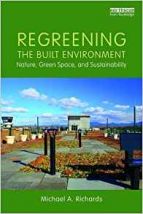Regreening the Built Environment: Nature, Green Space, and Sustainability

While environmental damage has in the past been accepted as an unfortunate but necessary victim of capitalism and urbanization, in Regreening the Built Environment Michael A Richards advocates a paradigm shift. The new paradigm sees the built and natural environments in a complimentary relationship that promotes sustainability on environmental, economic and social levels (page 5). It also calls for professions typically responsible for the built environment, like engineers, architects and planners, to gain greater understanding of ecological systems upon which their cities are built and also depend (page 210).
In this book, Richards asks us to rethink “what we build, how we build it, and even if it is necessary in the first place”, as he proposes “regreening” as a “unitary and holistic design process” (pages 1 and 5). Based on the United States, whilst drawing upon cases from around the world, he explores specifically the notion of regreening the built environment in reference to “green-infrastructure reclamation and regeneration strategies on roadways, sidewalks, parking surfaces, buildings/rooftops, corridors, and brownfields” (page 4). He says that whereas infrastructure and green space were viewed in opposition in the past, this book aims to illustrate how they can be one and the same thing.
Regreening the Built Environment comprises 12 chapters. The introduction sets the scene for the book and explains a new paradigm for the built environment.
Chapter 2 then unpicks why we need to regreen the built environment. This identifies reasons related to the physical, social and economic environments such as climate change, resource depletion, loss of biodiversity, public health, and sustainability.
In Chapter 3, Richards highlights the importance of ecological design that integrates design into living processes in nature (page 30). To illustrate this he shows how ecological analysis can reveal “optimum bio-climatic design strategies in relation to both energy, through renewable energy sources, and waste reduction” (page 31).
The importance of both land conservation and preservation in projects, master plans and regulations is the topic of Chapter 4.
Chapter 5 then describes different types of transportation, such as fixed guideway transit, that promote transit-oriented development. This provides an alternative to the automobile and offers relief from its negative impacts.
The following five chapters present specific green infrastructure strategies for: Roadways (Chapter 6); Parking Surfaces (Chapter 7); Buildings and Rooftops (Chapter 8); Corridors (Chapter 9); and Alternative Sites (Chapter 10). Interspersed in these chapters are case studies including real and hypothetical designs, which point to future potential in the built environment.
As a precursor to the concluding chapter, in Chapter 11 Richards considers how in practice we are to implement green infrastructure. He identifies changes in education, public policy, marketing and culture as imperative to regreen the built environment (page 209).
In his Concluding Remarks (Chapter 12), Richards states that a hard question we face is: “Can we simultaneously meet the spatial and tectonic needs of society and still conserve open space?” (page 226). He hopes that through his book he has provided clear evidence that it is indeed possible. He has illustrated in previous chapters not only that regreening strategies can be integrated into new development, but also that they can be applied to existing infrastructure.
Book note prepared by Hannah Keren Lee
Search the Book notes database
Our Book notes database contains details and summaries of all the publications included in Book notes since 1993 - with details on how to obtain/download.
Use the search form above, or visit the Book notes landing page for more options and latest content.
For a searchable database for papers in Environment and Urbanization, go to http://eau.sagepub.com/

